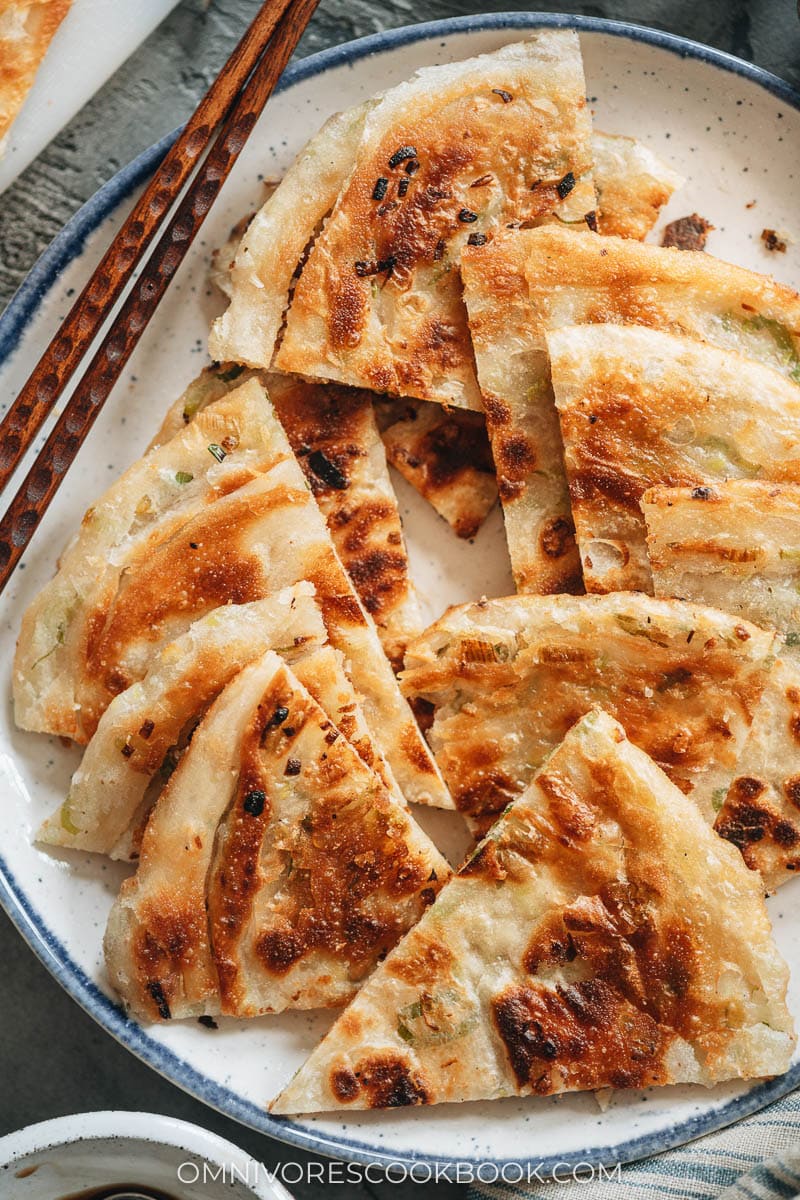
Chinese scallion pancakes are always such a hit at dim sum. You’ve likely seen them as an appetizer or side dish to go with all those stir-fry dishes that you love. But did you know you can make an even tastier version at home?
The secret to scallion pancakes is the crispy, flaky exterior that gives way to a slightly chewy interior of thin layers. When fresh-off-the-stove, it is extra crunchy and addictively fragrant. They are such a treat that you can enjoy them on their own, and they’re perfect for snacking. And your kids will adore them!
Once you’ve tried the homemade version, there’s no going back to takeout scallion pancakes.
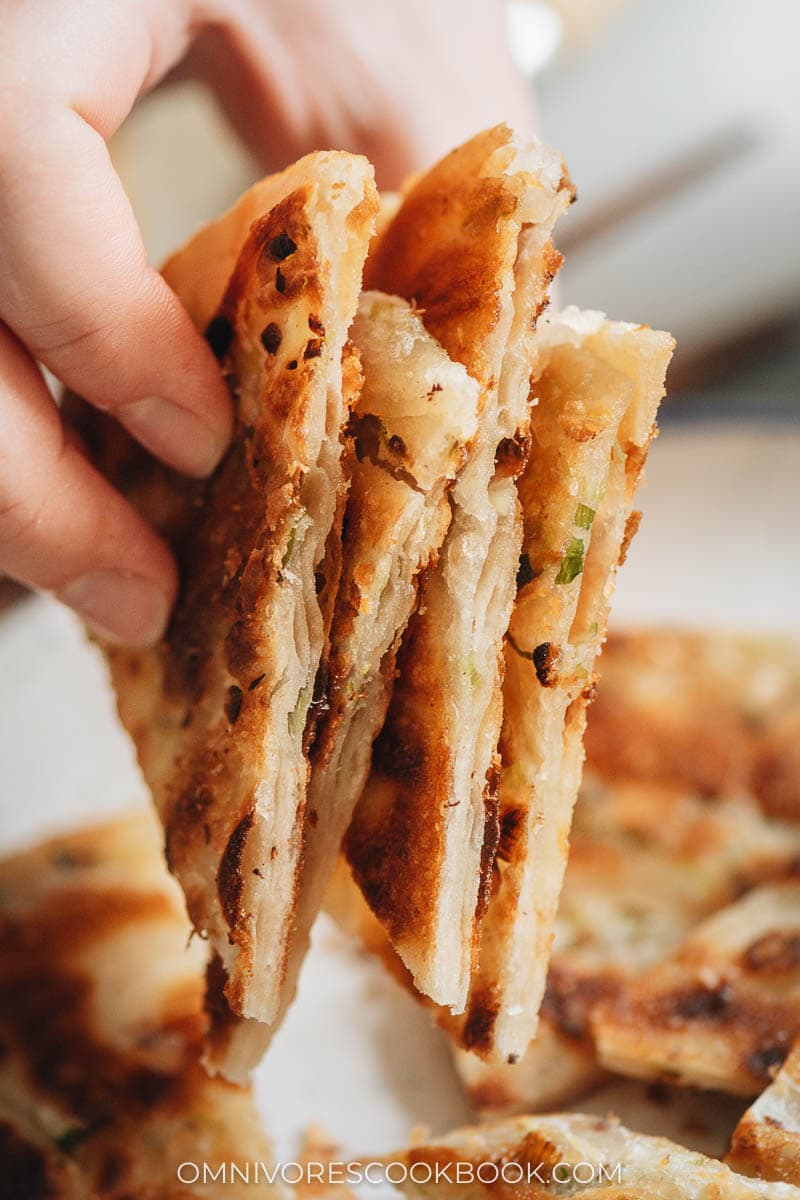
Why this recipe
I shared a recipe a few years ago and since then I’ve been perfecting the method. Today I want to share an updated version that uses even simpler ingredients to yield a better result.
- A dough that’s easy to work with and takes minimal time to prepare and rest.
- Delightfully crispy and flaky texture with thin layers inside.
- Extra green onion stuffing, giving it a more aromatic flavor.
- Skipped the animal fat while maintaining the flavor and the texture of the dish.
After many tests, we found out the perfect flour-to-water ratio to create a dough that is elastic and not too soft. So you will be able to work in more layers and create a better texture.
My previous scallion pancake used chicken fat. It was super delicious but it did require an extra grocery run. Plus, I’ve received many requests for a vegan/vegetarian version. Using this recipe, you can simply use regular vegetable oil with more green onion to create a very delicious result.
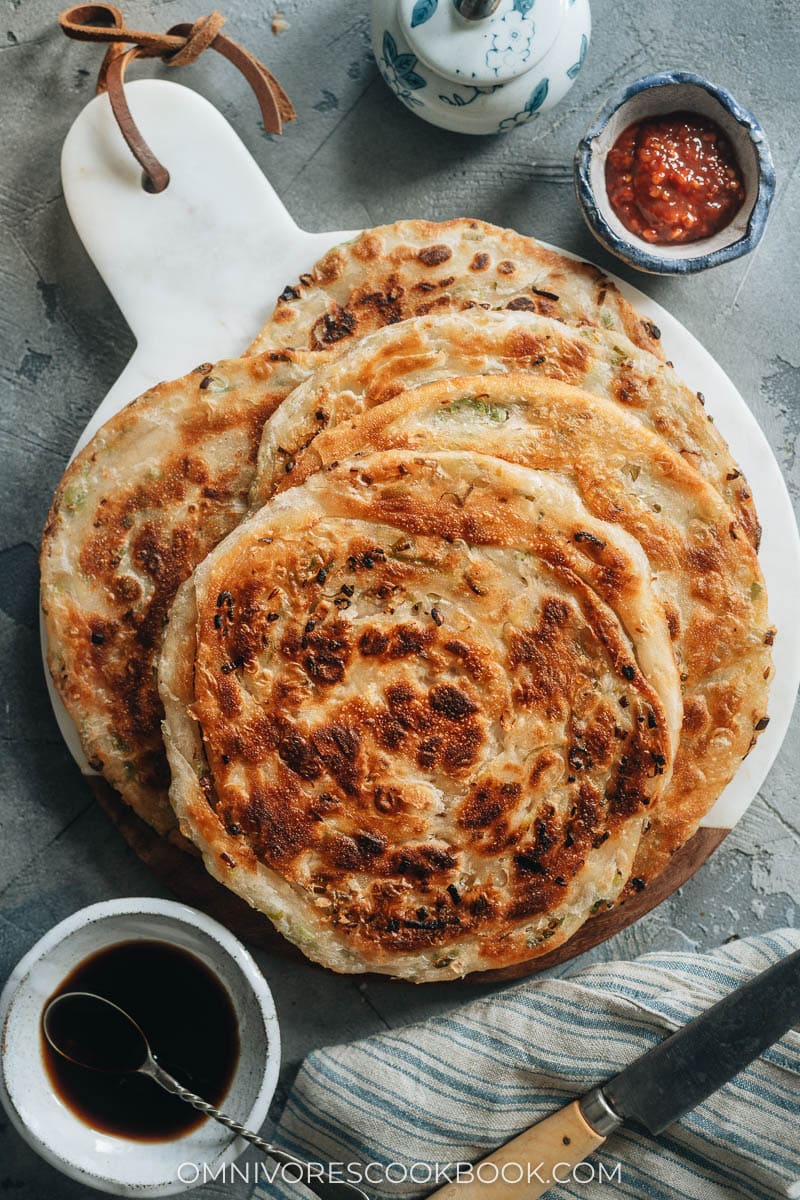
Ingredients
All you need are some basic pantry ingredients to make great scallion pancakes – all-purpose flour, water, salt, vegetable oil, and green onion.
To further boost the taste, you could add some ground Sichuan peppercorns to the filling, but it’s totally OK to skip them.
Extra green onion
How you cut the green onion can greatly affect the outcome of your scallion pancakes. Instead of thinly slicing it into round shapes, I prefer to:
- Halve the scallion lengthwise.
- Thin slice them into very small half-moon pieces.
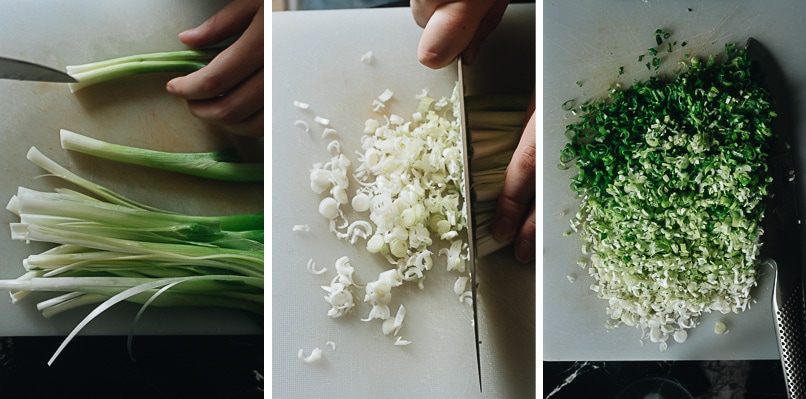
The smaller the green onion pieces, the easier it will become when you roll them up in the dough. This cutting method creates fewer air pockets and allows you to stuff more green onions.
What oil to use
Traditional Chinese scallion pancakes use lard, which makes it easy to work in the layers, and it adds a fragrant taste. I used to enjoy using chicken fat, because it creates an even more fragrant taste.
Over the years, I’ve tried to make my diet healthier, so I’ve tried using plant-based oil instead of animal fat. I found out that many oils work. My favorite is peanut oil, which adds a nutty taste to the pancakes. Olive oil and coconut oil work great too, if you enjoy their unique taste. If you use a neutral vegetable oil, you can blend in 1 tablespoon sesame oil to add fragrance.
Cooking process
Cooking scallion pancakes might look daunting at a glance. My detailed step-by-step photos will help walk you through how to prepare the dough and shape the pancakes like a pro.
Part 1 – Prepare the dough
If you’re making a big batch of scallion pancakes, you can use a stand mixer to make the dough. But I found it easy enough to knead the dough by hand.
- Slowly add the hot water to the flour and mix it at the same time.
- Mix until the hot water is fully absorbed
- Slowly add the cold water and continue mixing
- Dough flakes should form once all the water is added
- Start to press everything together with your hand
- You can add a bit more water if there’s too much dry flour left. Or you can slightly add a bit more flour if the dough is very sticky. Once you’ve pressed all the dough flakes together, you should have little or no dry flour left.
- Knead about 5 mins until a tough dough is formed.
- Let rest for 20 mins, then knead for 1 minute to form a smooth dough.
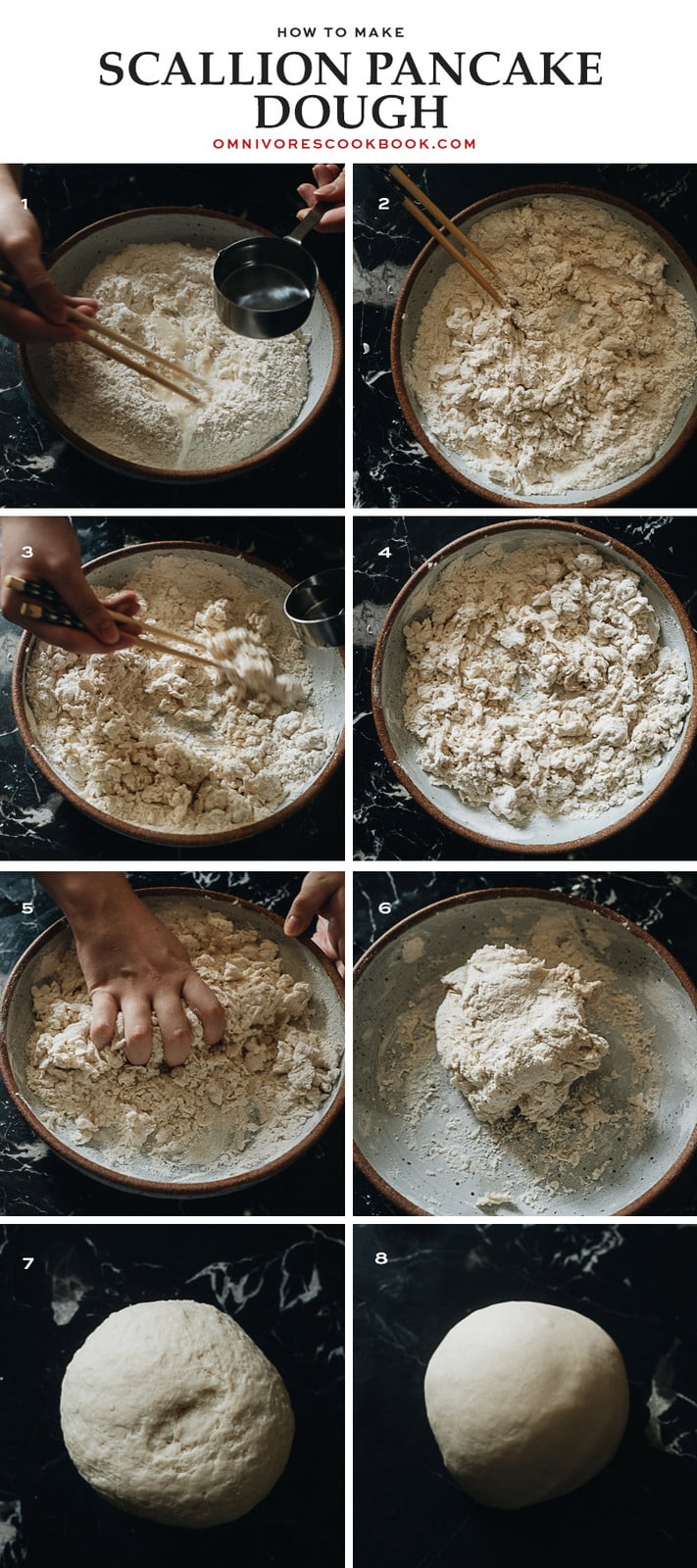
Part 2 – prepare the filling
The best way to make the scallion pancake filling is to make an oil flour paste (not simply brushing oil onto the dough). This way you can work in layers easily without pressing out the oil as you roll out the pancakes.
To make the filling, simply mix the dry ingredients with the oil until it forms a smooth paste.
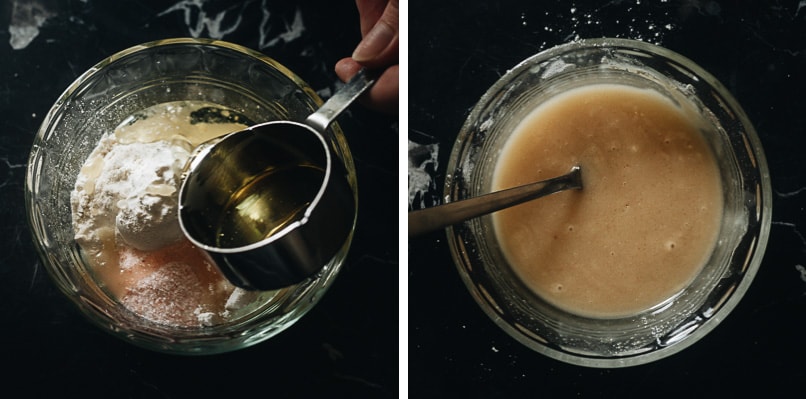
Part 3 – Forming the scallion pancakes
- Cut the dough into 6 pieces and work on the pieces one at a time. Use your hands to shape the dough into a rectangular shape.
- Roll the dough
- The dough should form a very thin rectangle.
- Add the flour oil paste
- Spread out the paste, leaving about 1” (2.5 cm) on both a long and a short end without the filling (your top and left)
- Add the green onion, concentrating most of it towards a long and short end with the filling
- Gently roll up the dough, as tightly as possible
- Press the air bubbles out of the dough strip
- Further roll up the long dough strip
- Tuck the end on the bottom
- Gently press the tall pancake
- Let it rest while you work on the rest of the pancakes

PS. I prefer to rest the formed pancakes for a few minutes before rolling them out, to let the gluten relax, so you can roll them out easily.
NOTE: the photos were shot on the opposite side of the table from where the pancakes were made. If the recipe description looks upside down or confusing, check the video at the bottom of the recipe so you can get a better idea.
Part 4 – Roll and cook the pancakes
- Roll out the pancakes when you’re ready to cook
- Heat up a pan with a layer of oil on the bottom, add the pancake, and wiggle the pancake a few times so it won’t stick
- Let the pancake cook covered first
- Flip the pancake and cook covered again
- Then cook uncovered, until both sides of the pancake are browned
- You can use a spatula to press the pancake, to help with even browning
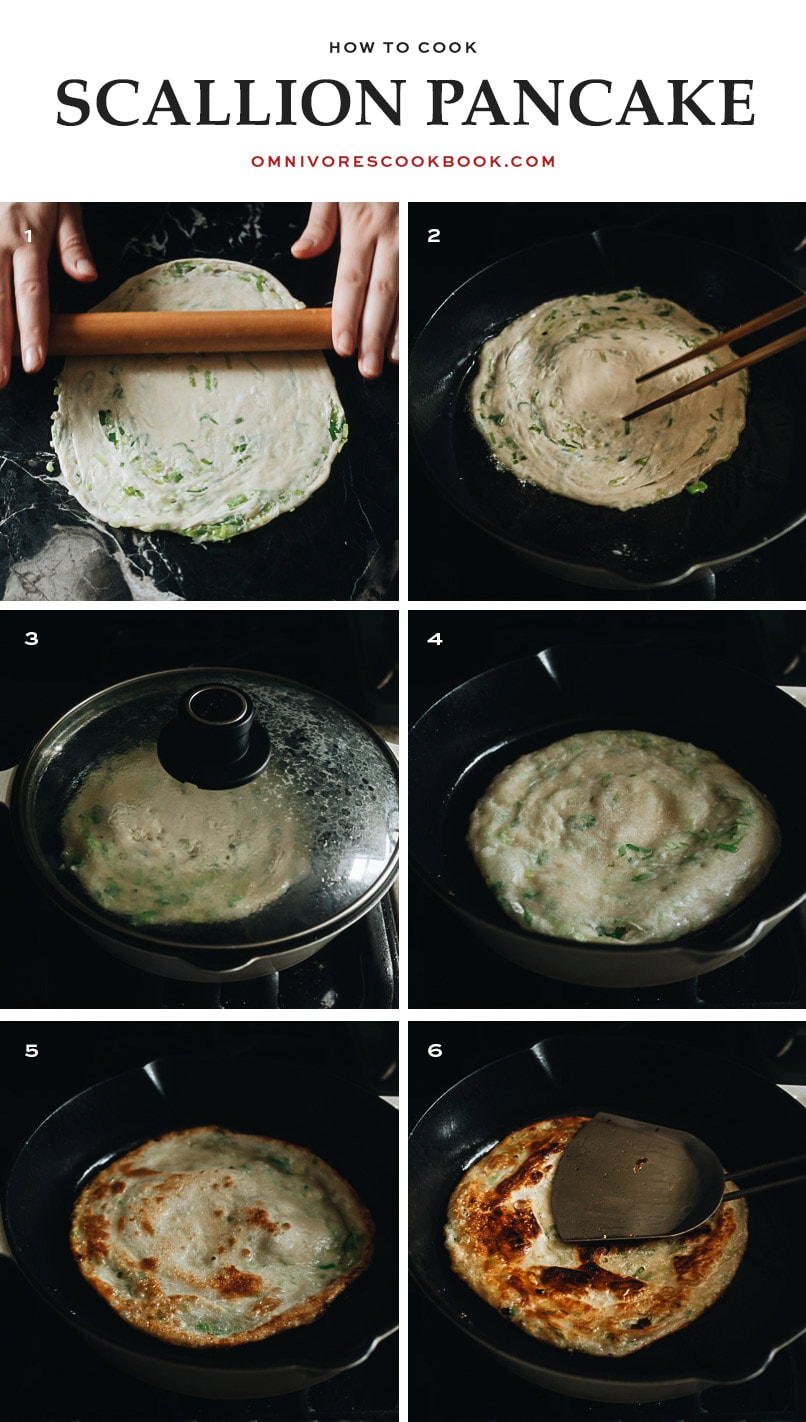
NOTE:
- You can either use a cast iron skillet or a nonstick pan. Either will work. If you use a cast iron pan, you will need a generous amount of oil to prevent the pancakes from sticking.
- It’s possible to use less oil to cook the pancakes. But for the best result – golden brown surface and extra crispy texture, you will need a thin layer of oil to cover the bottom of the pan (not just a few drops).
- It’s important to cook the pancakes covered at first, to cook through the interior.
How to store scallion pancakes
The best thing about these pancakes is that they can be stored raw or cooked.
If you’d like to get the best fresh result, freeze the scallion pancakes raw after you roll them out. Carefully stack them with a piece of parchment paper in between, then transfer everything to a large ziplock bag. Press out as much air as possible and seal the bag. Freeze the pancakes for up to 3 months.
To cook the frozen pancakes, simply let them thaw at room temperature for 8 minutes and cook them using the same method.
If you cook all the pancakes and have leftovers (very unlikely!!), you can put them in a bag and store them in the fridge for a few days. You can either reheat them in the microwave or on the stovetop. Note, if you reheat a cooked pancake, it will still be quite crispy but the texture will turn a bit chewier.
Afterthought
Chinese scallion pancakes do take a little time to prepare and the recipe might look ridiculously long. But compared to other classic Chinese dim sum, this one is actually easier to make. If you’re new to dim sum making but love bread, this is a great place to start.
These scallion pancakes taste so good that I would refrain from making them often, because I’ll just eat them all (lol). But these are my favorite and they taste so much better when you make them at home. Since you can make them ahead and freeze them for later, they are perfect when friends or family come by. If you’ve never had them before, you’re absolutely going to be in love at first bite!
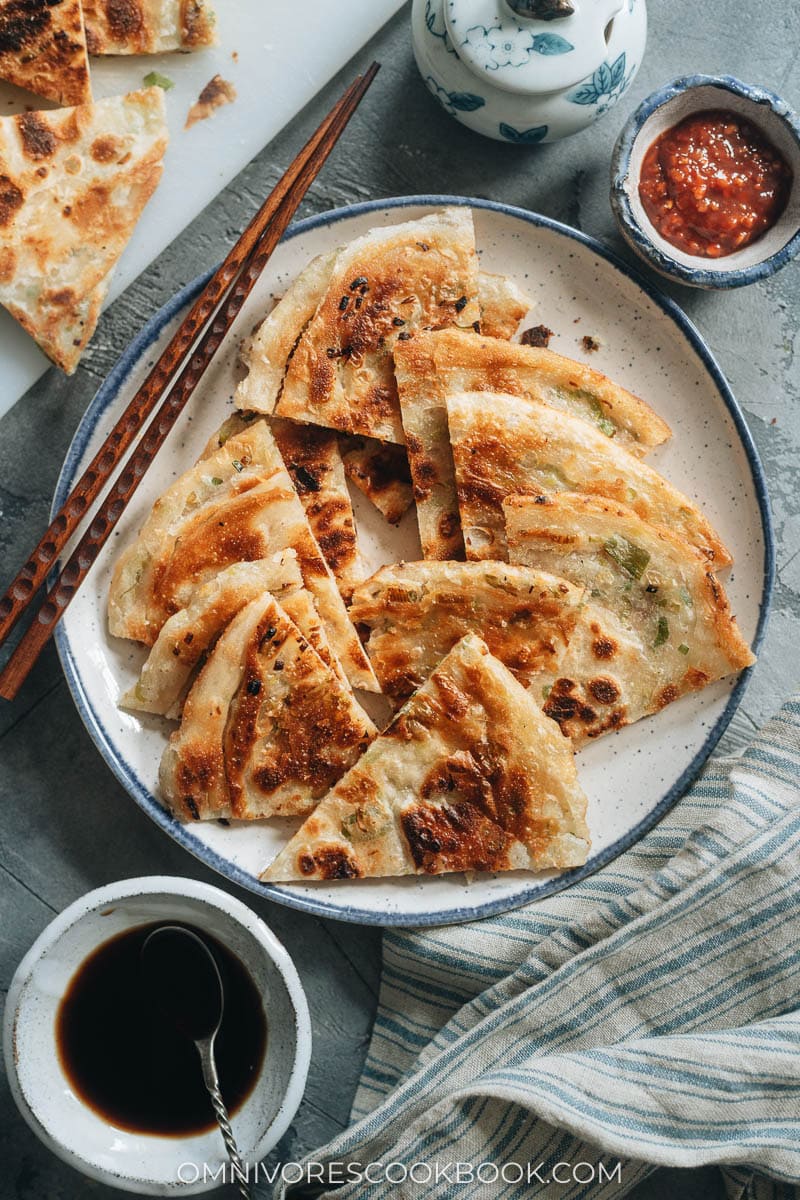
Dishes to serve with
Complete your Chinese restaurant style dinner with these dishes below:
- Mapo Eggplant
- Salt and Pepper Pork Chops
- Chinese Egg Drop Soup
- Chicken Fried Rice
- Sweet and Sour Pork
- Chinese Chili Garlic Shrimp
Want to learn more about Chinese Cooking? Sign up my newsletter to receive the 5-Day Chinese Cooking Crash Course and recipe update!
Chinese Cooking Made Easy
Are you new to this website? This free email series is a great place to start. I’ll walk you through a few of my most popular recipes and show you how and why they work. You’ll quickly start to cook better Chinese food in your own kitchen.
Watch video
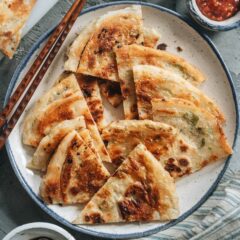
Chinese Scallion Pancakes (葱油饼)
Ingredients
Dough
- 2 cups all-purpose flour
- 1/2 teaspoon salt
- 1/2 cup boiling water
- 1/4 cup cool water
Filling
- 1/3 cup all-purpose flour
- 1/4 cup peanut oil (or your favorite oil like olive oil, melted coconut oil, melted butter, or melted chicken fat etc.)
- 3/4 teaspoon salt
- 8 green onions , split down the middle and chopped (yield 1 cup)
Cooking
- Vegetable oil for pan frying
Dipping Sauce (Optional)
- 1 1/2 tablespoon soy sauce
- 1 tablespoon Chinkiang vinegar (or rice vinegar)
- 1/4 teaspoon sugar
Instructions
Make the dough
- OPTION 1 – USING YOUR HANDS: Combine the flour and salt in a big bowl. Stir to mix well. Slowly drizzle in the hot water while mixing it with a pair of chopsticks (or a fork), until the water is fully absorbed. Slowly drizzle in the cool water, continuing to stir until many dough flakes form. Press the dough together, and try to combine the wet dough with the dry flour. Drizzle in a little extra water if there is any dry flour remaining. Knead until a firm ball is formed, about 5 minutes. Cover and let rest for 20 minutes.
- OPTION 2 – USING A MIXER: Combine the flour and salt in the mixer bowl with the dough hook attachment. Turn it to the mix setting and slowly drizzle in the hot water followed by the cool water. After a minute of mixing, drizzling in a little extra water if there is any dry flour remaining. Turn to setting 4 and knead until a ball of dough is formed, about 3 minutes. Cover and let rest for 20 minutes.
Make the filling
- While the dough is resting, combine the flour, oil, and salt in a small bowl. Mix until a smooth paste is formed.
- If making the dipping sauce, combine all the ingredients with 1 tablespoon of water in a small bowl and mix until the sugar is dissolved.
Form the scallion pancakes
- When the dough is done resting, knead for another minute until it is smooth. Cut the dough into 6 even pieces, about 76 grams per piece. Form the dough into balls using your hands.
- Work on one dough ball at a time, covering the rest with plastic wrap to prevent drying out. Roll each dough ball into a thin rectangle with a rolling pin, aiming for around 6×10” (15×25 cm). Lift and turn the dough regularly as you roll it to prevent sticking. Spoon about 1 tablespoon of the filling onto the dough and spread it evenly with the back of a spoon, leaving about 1” (2.5 cm) on top and the left end without the filling. Sprinkle 2 heaping tablespoons of green onions onto the paste, concentrating most of it towards one side of the length and one side of the width, creating a loose L shape (see the blog post above for the step-by-step pictures).
- Begin rolling the dough from the longer side of the dough where the green onions are concentrated, until you have one long tube. Lightly flatten the tube using your hand. Pinch the side with more green onion to seal it. Take the sealed side and gently pull and roll it towards the unsealed side, using your hand to smooth out the dough to push any large air bubbles out. Tuck the loose end under the rolled bun. Gently press down on the round disk with your hand to seal the pancake.
- Set the formed pancake aside and cover it with plastic wrap. Repeat steps 4 and 5 until each pancake is ready.
Roll out the pancake
- Roll each prepared pancake into a circle, about 7-8” (17-20 cm) wide. Flip and move it as you do to prevent sticking. Don’t worry if air bubbles burst through or some green onions fall out.
- If you plan to store the pancakes and cook them later, place each pancake onto a piece of parchment paper and stack them. Transfer the pancakes to a large ziplock bag, squeeze out as much air as possible, and seal the bag. You can freeze the pancakes for up to 3 months.
Cook the pancakes
- Heat a 9” (23 cm) cast iron pan (or a nonstick skillet) over medium-high heat and add enough oil to fully coat the bottom. Once the oil is hot, add a pancake. Use a pair of chopsticks (or a spatula) to swirl the pancake around to spread the oil and prevent sticking, for a few seconds. Cover the pan and turn the heat down to medium. Let the pancake cook, covered, for 1 minute. Remove the lid and flip the pancake, cover, and cook for another minute. Remove the lid. Use a spatula to press the pancake, to ensure even browning. Continue to cook, flipping regularly, until both sides are crisp and browned, about 3 minutes. Turn to medium-low heat if the pan gets too hot. Transfer the pancake to a cooling rack or a cutting board to cool. Repeat to cook all the pancakes you plan to serve.
- Once the pancakes are slightly cooled enough to handle, cut into 6 pieces and transfer to a serving platter. Serve hot with the dipping sauce as an appetizer.
Cook frozen pancakes
- Let the frozen pancakes thaw for 10 minutes then proceed from step 8.
Store and reheat cooked pancakes
- Place the leftover pancakes in a ziplock bag by stacking them together. Store in the fridge up to 3 days. To reheat, add a pancake to a pan and heat over medium heat, cook, flip occasionally until the pancakes turn warm throughout.
Nutrition

Did you make this recipe?
I’d love to hear how it turned out for you! Please take a moment to leave a 5-star rating ⭐️ and share your thoughts in the comments further down the page. It really helps others discover the recipe too.
If you give this recipe a try, let us know! Leave a comment, rate it (once you’ve tried it), and take a picture and tag it @omnivorescookbook on Instagram! I’d love to see what you come up with.
Other classic dim sum recipes
- Pineapple Buns (Bolo Bao)
- Chinese Steamed Custard Buns (nai wong bao, 奶黄包)
- Char Siu (Chinese BBQ Pork, 叉烧肉)
- Char Siu Bao (Steamed BBQ Pork Buns) 叉烧包
- Chinese Chive Pockets (韭菜盒子, Chinese Chive Dumplings)
- Chinese Turnip Cake (Lo Bak Go, 萝卜糕)
Lilja Walter is a part of the Omnivore’s Cookbook team and worked closely with Maggie to develop and test this recipe.

Alison
I’ll need rondo a sourdough version but otherwise fantastic. Thank you from Melbourne Australia.
Melanie Sparkes
Hi I made these today as a treat and I ate one whole I was cooking them they smelt so lovely! My paste was a bit thicker than yours, I used a mix of shortening, sesame oil and a bit of beef fat but they tasted nice though probably not as light and fluffy as they should be! Thanks for the recipe. I found these more challenging than dumplings and noodles but as always, worth the effort.
Yumtum555
Try some time using an all purpose flour fed sourdough starter and when you mix the starter with more flour to turn it into a dough add a gluten free flour like buckwheat or rye. It will bring down the gluten content and the sourdough starter also gives it a tiny bit of fluffy rise and crispy exterior along with a slightly chewy core and a nice savory flavor that is delicious when it’s seasoned. Maybe not traditional but really good and a good use for your throwaway starter every morning. I like it far more! I also top it when an egg and a little red wine vinegar mixed in soy sauce with a few spurts of my favorite hot sauce or Korean chili flakes if I have them (because I prefer the sun dried taste of them over regular chili flakes). The flour is a bit hard to work with the first few times because it’s sticky and the low gluten makes it fall apart quickly if you over handle it. You get the hang of it after a few attempts though.
Nice
Tried your recipe. they are pretty good. Ive been making them with sourdough yeast though instead of flour and I think they just come out better. Esp if you time the feeding right… like when i do regular pancakes i want the yeast very active but when I do the scallion pancakes i take it from when the yeast is hungry and theres sour water pooled on the top, I just add a little tiny bit of flour and give it like 10 minutes to start bubbling then throw it on. It gets a nice chewy sour texture in the center and crispy on the outside with just a little tiny bit of rise since the yeast is not most active yet and I really like them like that. I think I’ll stick to the sourdough ones, but if I didnt have sourdough being fed all the time to make bread, I would certainly use this recipe. it was good too and far different than how i make it.
Jim
Thank you for the recipe. The pancakes came out perfect. They are so good that they reminded me the ones that I had in Taiwan.
Katy
Wonderful recipe! Can I use the dough cycle of bread machine to make the dough?
Thanks!
Katy
Maggie
Hi Katy, I’m not so sure about it because I’ve never used a bread machine to knead this dough. I think it might be a bit tricky because the recipe calls for the hot water first, then you need to blend in cold water into the dough. If you can add water two times into the machine, I assume that it will work.
Meldie
I want to try this but am a little bit confused. Ingredients calls for 1 and 1/2 cup chinese all-purpose flour. But in footnote 1, you say we need a total of 2 cups chinese flour (1 1/2 for dough and 1/2 for paste). This I understood. But then you go on to say to make the flour, combine 2 cups all-purpose flour and 1 cup pastry flour (3 cups) and scoop out 1/2 cup for paste . This leaves behind 2 1/2 cup. this is 1 cup more than what the ingredients show. Which one is correct?
Maggie
Hi Meldie, the recipe calls for 2 cups Chinese flour in total (1 1/2 for dough and 1/2 for paste). I did call for blending 3 cups simply because it is easy to measure. And yes, you will end up with 1 cup extra. I usually use the extra flour to dust the working surface. I hope this clear up the confusion.
Happy cooking and can’t wait to hear how your pancakes turns out 🙂
Meldie
I finally made this. Although it seems to me the ratio of water compared to flour was a lot, I started following your recipe with 1.5 cup flour and 1 cup boiling water and 1/4 cup cold water. The batter turned out more like pancake batter than dough. I ended up adding more flour in which in the end totaled 2.5 cup flour. But the Green Scallion pancake turned out wonderful at the end. It was delicious.
Maggie
Hi Meldi, thanks so much for reporting back and I’m glad to hear the pancakes turned well.
After another thorough checking and comparing to the original recipe, I found out you were right about the flour measurement afterall! The grams measurement was correct in my recipe, but the cups are off. It should be 2 1/2 cups instead of 1 1/2 cups, as you indicated in your previous comment. I just updated the recipe with the correct measurement. Sorry about the confusion but I’m happy that you made the right call while making the pancakes 🙂
CL
Great recipe! Easy to follow and came out tasting fantastic!
Lynn
Thank you for the write up. Delicious! The video showing the texture of the dough helped a lot. I did not have the Chinese all purpose flour, nor did I have pastry flour on hand, so I substituted the regular AP flour (I am in Canada) with a bit of wheat starch I had in the pantry, from the Chinese grocery store (I used 1 1/3 AP flour plus 2 Tbsp to make up about 1 1/2 C, and about 1 Tbsp for the 1/3 C of AP flour to make the paste. Along the lines of what is suggested here: http://www.recipies.50webs.com/undestanding%20flour.htm.
Kirsty Wong
Thank you so much!!
I was looking for a good scallion pancake recipe, and all of the ones I had seen didn’t look as good as the ones I normally eat. Tweaked the recipe a bit, I used 6 stalks of scallions and a mixture of chicken and pork lard. It’s so good and so simple! I even impressed my mom which says a lot cause she’s a harsh judge when it comes to Chinese food. I’ve made this recipe 3 times already within a week.
My favourite way to eat it is with leftover chinese braised beef brisket, cilantro, extra scallions, chilies and hoisin.
Thanks again!!!
Maggie
Hi Kirsty, wow, I can’t believe you’ve cooked the dish so many times in a week! You’re a great cook 🙂
Just like you said, I also found many scallion pancake recipes out there are not as great as the ones I ate in China. I was so happy when I discovered the method in the cookbook All Under Heaven. And I’m glad to hear that your mom likes it too! My mom is very harsh about my cooking too, so I totally get you 😉
Braised beef brisket + scallion pancake, YUM! Think I’m going to cook a new batch soon.
Thanks for taking time to leave a comment Kirsty! Have a delicious week ahead 🙂
Christi
Lovely! Today is Chinese new year and i am looking for something to cook for my family instead of letting my mother in law do it all. This is a perfect recipe as i was gifted a bag of beef lard (strange gift, i know!) so i am going to try that this afternoon while watching 春节晚会. Happy New year to you!
Maggie
Hi Christi, I’m happy to hear you decided to try out this recipe! It’s a perfect dish to celebrate Chinese New Year. Beef lard for gift? That’s not so strange in China 😉 It makes amazing pancakes, fried noodles and fried rice!
Happy Chinese New Year!
Sabrina
this is really interesting information (for ex: animal fat in this recipe vs sesame oil and pastry flour substitute), so thank you for sharing this wonderful recipe!
Victoria
This recipe is amazing! flaky, delicious and simple too! The dough was so easy to work with.
I tried it after trying and being disappointed with two other recipes (one of them was the serious eats recipe from Kenji Lopez). The modification to the flour, and paste (instead of oil) really makes a difference. The other recipes also want you to repeat the entire process of rolling flat–>oil–>rolling up two times instead of once and I think that probably stretches out and mushes all of the layers into one oily mass instead of increasing the number of flakes. It’s also so much more work.
I do have a question though, I noticed that every time I fry the pancakes there is a little bit of doughiness in the middle–is there anyway to get it flaky throughout or is it impossible? I roll the pancakes out pretty thin and have tried lower heat+longer cooking time but there’s always some doughiness that remains!
Maggie
Hi Victoria, I’m so glad to hear you tried my recipe and liked it! Yes I came across the same problems before I came across this recipe.
To answer your question, no I haven’t found a great solution yet. Because the way you roll up the pancake, the center part is the most dense and more difficult to cook through. The only solution might be – roll the pancakes super thin, and then fry them in a lot of oil. I’ve sampled super crispy pancakes in restaurant (in China). It’s almost like a fried dough. So delicious without the doughiness in the middle.
Btw, I don’t recommend to turn the heat too low. It tends to dry out the dough if you don’t use enough oil.
Jennifer Essad
I’ve not heard of Chinese flour, with less gluten I’m sure it’s one we could incorporate into recipe successfully
cooking video
awesome chef you done your challenge very well and its look too much delicious
Kathleen | Hapa Nom Nom
Oh Maggie! I don’t even know where to begin! I think I’m in love! Seriously, this looks absolutely AMAZING! I can see why you miss it since moving to Austin. Sharing everywhere!
Maggie
I wish you live next door so we can share these pancakes together 🙂 I seriously think you’ll love its taste!
Have a great week ahead Kathleen 🙂
Bam’s Kitchen
Now that is a challenge! These little scallion pancakes always seemed like a huge amount of work to me too. Great video! Looks so crispy and delicious! My favorite! So many congratulations to you dear Maggie! Yeah on getting featured in Austin American-Statesman! Also another good job well done on completing your online course. I would celebrate by eating more of your delicious scallion pancakes. Sharing everywhere!
Maggie
Great to see you here and thanks for all the kind words! Hopefully we could get together and cook some time. It will be a delicious meal I’m sure 🙂
Sorry I haven’t got back to your last email yet. Will be in touch soon. Have a wonderful week ahead Bobbi!
Tiffany
I actually enjoyed using this recipe! My friend recommended it to me and it turned out so crispy and flaky! My recommendation is to add some Chinese 5 spice to give it that extra umph to the flavor. I would definitely be using this recipe again!
Anne’s Kitchen
These look absolutely delicious! I wish we could get chicken fat in Luxembourg, but I’ve never seen it! Do you think it would taste good with goose fat instead? I might give it a try… Thanks for sharing the recipe!
Maggie
I’m glad to hear you like the dish Anne! I’ve never used goose fat before but I believe it will be delicious as well!
Happy cooking 🙂
Tole
If you ever cook a whole chicken, of course do not remove any of the fat or skin, when it’s cooked, let it sell a few minutes and cool a little and just skim the fat of and store in a jar in the fridge. That;s the purest and finest chicken fat, no additions to it. I always save a little for when I make a vegetable soup or stew.
Charlie
Hi Maggie!
These look delicious.
When my children were at home and now for my grandchildren I made/make creamed chicken on waffles. (They love them).
These would be so great to substitute for the waffles. Much lighter and more flavourful.
Have to give them a try.
Thank you for sharing
God Bless
Maggie
Hi Charlie, I’m glad to hear you like this dish! It is one of my favorite breakfast items, but I’ve never served it with chicken. It sounds so delicious and I can’t wait to try out 🙂
Kumari
I love Chinese food. My husband always trying to cook Chinese food. My favorite dish is mongolian beef.
Pancake looks so delicious ?.
I am going to try this definitely.
Thanks
Maggie
I’m glad to hear you like Chinese food Kumari! Me too, I like Mongolian beef. I hope your cooking turns out great 🙂